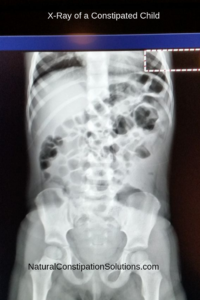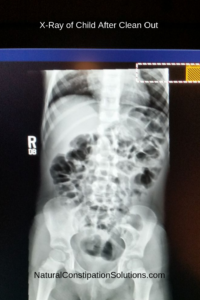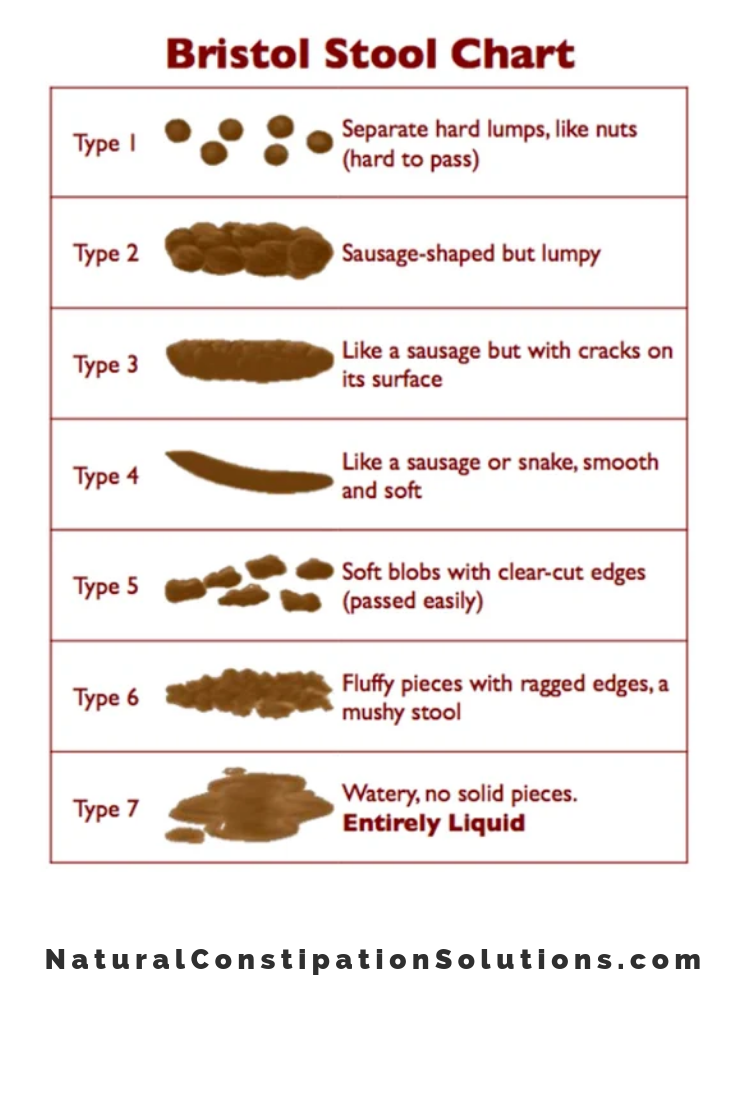The Bristol Stool Chart, Am I Constipated?
Ideally, if you are not constipated, you will be having a type 3 or 4 bowel movement, 1-3 times a day. Constipation is generally considered having less than three stools a week and having hard to pass stools. If you are passing stools that look like type 1 or 2 on the Bristol Stool Chart, then you are constipated even if you are going daily or even multiple times a day.
You can also be passing type 5 or 6 stool and still be constipated! Confusing, I know! If you have a hard ball of stool up in your intestines, you can be passing soft to liquid stool that is seeping around the hard ball of stool.
Often it takes an X-Ray to determine the extent of your constipation.
Bloating, gas, large hard to pass stools, foul-smelling stools, a hard distended tummy, pain, cramping, straining when going, red blood on the stool or when you wipe, can all be signs of constipation.
Common causes of constipation are diet and eating food that they are intolerant of or allergic to, dehydration, low magneisum, lack of fiber in the diet or too much fiber in the diet, a side effect of medication or antibiotics, lack of good gut bacteria, undiagnosed or under-treated hypothyroidism, Dairy, Celiac Disease or non-Celiac Gluten Sensitivity.
If you are unsure if you are constipated, your doctor can push on your stomach and get a good idea of how constipated you are or he or she can send you for an X-ray. An X-ray can determine the level of constipation.
If your doctor or Gastroenterologist sends you to get X-rayed, it can be hard to know what to look for in the X-ray. Usually, the doctor will give you a report on what they saw in the X-ray but if you are sent off-site for the X-ray, it can take time to get the report. I am not an X-ray tech, but from what I have been told, the grey/white areas in the intestines are the stool and the darker black areas are gas/air. Below are examples of what an X-ray of a constipated child looks like and what an X-ray after the child has been cleaned out of stool look like.


My son had an X-ray to determine if he was constipated when he was 4 years old. He was having daily bowel movements and the stool was coming out very soft, a type 5 or 6 on the Bristol Stool Chart, but he seemed to be struggling and was in pain. He had been diagnosed with Celiac at 18 months and dairy intolerance from birth. I had him on a strict gluten free, dairy free diet but something was still wrong. His pediatrician referred us to a Pediatric Gastroenterologist at a prestigious teaching hospital 2 hours from our home.
After an exam and an X-ray, the Pediatric Gastro said that my son had a hard mass of stool high up in his intestines and the stool that we were seeing come out, was actually leaking around the hard mass. He also diagnosed my son with Megacolon from the X-Ray. Megacolon is a large stretched out intestine. Often when you have Megacolon you don’t have the same urge to go that other people have. Megacolon can be caused by chronic constipation stretching out the intestines and colon or it can be a birth defect like my son’s was, where the nerves didn’t travel down the intestines properly during the first trimester of pregnancy.
Based on the X-Ray, the Pediatric Gastro recommended that we do a Miralax cleanout and then daily doses of Miralax for maintenance. I questioned the safety of Miralax but the Pediatric Gastro assured me that is was “Safe as Water” and “Not absorbed.” The Pediatric Gastroenterologist was the head of Pediatric Gastroenterology at a well-respected teaching hospital so I trusted him.
Unfortunately, Miralax caused horrible side effects in my son and was the beginning a nightmare that I hope no other families have to go through, which is why years later after I had healed my son from his Miralax injury and gotten his constipation under control with natural means, I started my website.
As I did research into Miralax, I discovered that many people were suffering horrible side effects from Miralax including, Rage, Aggression, OCD, ADD, Tics, Seizures, Panic Attacks, Kidney problems, Autism-like behaviors, ODD, Night Terrors, Learning Delays, Mouth Sores, Lack of Growth, Hallucinations, Speech Issues, Numbness C. Diff and even homicidal and suicidal ideation. If you are concerned about Miralax and would like to learn about my son’s story and the stories of many others who have suffered serious side effects from Miralax, please read Is Miralax Safe to Give to My Child?
To have a bowel movement, Magnesium is generally a safe and effective choice. Magnesium Citrate and Magnesium Oxide (Milk of Magnesia) were commonly prescribed for constipation and clean outs prior to the invention of Miralax. For short-term use, Natural Calm Magnesium is very effective and generally well tolerated.
Most people are magnesium deficient. Blood tests for magnesium only show what is in the blood which is less than 1% of the total magnesium in your body and really doesn’t give a very good picture of your needs. The RDA for magnesium is what is needed to not have serious side effects of magnesium deficiency. Not what you need to be optimal.
Each person is different, and what you will need to be optimal is different, especially if you have been deficient for years. It will take a long time to build up your stores of magnesium. Dosing will be trial and error as you figure out what works best for you. It may change over time as your magnesium stores fill up. You are looking to dose to the point of 1-3 soft easy-to-push-out stools a day, ideally once after each meal. If you aren’t trying to do a clean out and you get loose stools, then back off on the dose. If you have hard, painful stools, increase the dose. It may take more magnesium than you expect to get to soft stool. Sometimes, it takes giving the magnesium overnight to kick in and work.
Implementing “Try Time” 20-30 minutes when you wake up in the morning and after each meal can be a wonderful help in getting on a routine of going and having daily bowel movements. Sit on the toilet for 5-10 minutes and see if you can go. If you can’t, it’s ok. Try again after the next meal. You don’t want to sit and try for too long as this can contribute to hemorrhoids.
If your stools are hard and painful to pass, coconut oil can be a wonderful way to lubricate the stools and help them pass. If you are looking for a tasty way to increase their coconut oil consumption, my recipe for Chocolate Coconut Oil “Poop Candy” can be a treat and very effective in producing a bowel movement. My Homemade Electrolyte Drink for Constipation has also helped a lot of people to get things moving.
If you are struggling with constipation and have been for a while, no amount of magnesium is going to work if you are gluten intolerant or have Celiac and still eating wheat or dairy intolerant and still eating dairy products. My article Finding the Root Cause of Constipation will help you to figure out why you are constipated and give you a game plan to get past it.
For support and information on constipation and safe alternatives, please consider joining the Facebook groups People Against Miralax or Natural Constipation Solutions.
This post contains Affiliate links.
*DISCLAIMER, I AM NOT A DOCTOR OR MEDICAL HEALTH PROFESSIONAL. ALL IDEAS DISCUSSED AND DESCRIBED IN THIS POST ARE MY OWN AND ARE NOT MEANT TO TREAT OR DIAGNOSE. IF YOU HAVE A MEDICAL CONDITION PLEASE SPEAK WITH YOUR DOCTOR.



